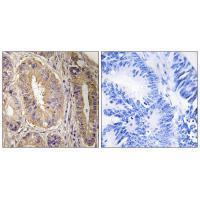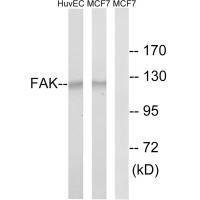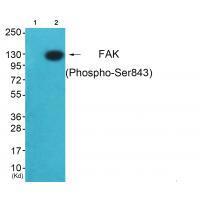Product Detail
Product NameFAK (Ab-843) Antibody
Host SpeciesRabbit
ClonalityPolyclonal
PurificationThe antibody was affinity-purified from rabbit antiserum by affinity-chromatography using epitope-specific immunogen.
ApplicationsWB IHC
Species ReactivityHu
SpecificityThe antibody detects endogenous levels of total FAK protein.
Immunogen TypePeptide
Immunogen DescSynthesized peptide derived from Internal of human FAK.
Target NameFAK
ConjugateUnconjugated
Other NamesEC 2.7.10.2; FADK 1; FAK1; Focal adhesion kinase 1; pp125FAK
Accession NoSwiss-Prot: Q05397
NCBI Gene ID: 5747
Uniprot
Q05397
Gene ID
5747;
Sdspage MW120kd
Concentration1.0mg/ml
FormulationRabbit IgG in phosphate buffered saline (without Mg2+ and Ca2+), pH 7.4, 150mM NaCl, 0.02% sodium azide and 50% glycerol.
StorageStore at -20˚C
Application Details
Western blotting: 1:500~1:3000
Immunohistochemistry: 1:50~1:100
Immunohistochemistry analysis of paraffin-embedded human colon carcinoma tissue, using FAK (Ab-843) antibody #33214.
Western blot analysis of extracts from HUVEC cells and MCF-7 cells, using FAK (Ab-843) antibody #33214.
Western blot analysis of extracts from HeLa cells (Lane 2), using FAK (Ab-843) antiobdy #33214. The lane on the left is treated with synthesized peptide.
Non-receptor protein-tyrosine kinase that plays an essential role in regulating cell migration, adhesion, spreading, reorganization of the actin cytoskeleton, formation and disassembly of focal adhesions and cell protrusions, cell cycle progression, cell proliferation and apoptosis. Required for early embryonic development and placenta development. Required for embryonic angiogenesis, normal cardiomyocyte migration and proliferation, and normal heart development. Regulates axon growth and neuronal cell migration, axon branching and synapse formation; required for normal development of the nervous system. Plays a role in osteogenesis and differentiation of osteoblasts. Functions in integrin signal transduction, but also in signaling downstream of numerous growth factor receptors, G-protein coupled receptors (GPCR), EPHA2, netrin receptors and LDL receptors. Forms multisubunit signaling complexes with SRC and SRC family members upon activation; this leads to the phosphorylation of additional tyrosine residues, creating binding sites for scaffold proteins, effectors and substrates. Regulates numerous signaling pathways. Promotes activation of phosphatidylinositol 3-kinase and the AKT1 signaling cascade. Promotes activation of MAPK1/ERK2, MAPK3/ERK1 and the MAP kinase signaling cascade. Promotes localized and transient activation of guanine nucleotide exchange factors (GEFs) and GTPase-activating proteins (GAPs), and thereby modulates the activity of Rho family GTPases. Signaling via CAS family members mediates activation of RAC1. Recruits the ubiquitin ligase MDM2 to P53/TP53 in the nucleus, and thereby regulates P53/TP53 activity, P53/TP53 ubiquitination and proteasomal degradation. Phosphorylates SRC; this increases SRC kinase activity. Phosphorylates ACTN1, ARHGEF7, GRB7, RET and WASL. Promotes phosphorylation of PXN and STAT1; most likely PXN and STAT1 are phosphorylated by a SRC family kinase that is recruited to autophosphorylated PTK2/FAK1, rather than by PTK2/FAK1 itself. Promotes phosphorylation of BCAR1; GIT2 and SHC1; this requires both SRC and PTK2/FAK1. Promotes phosphorylation of BMX and PIK3R1. Isoform 6 (FRNK) does not contain a kinase domain and inhibits PTK2/FAK1 phosphorylation and signaling. Its enhanced expression can attenuate the nuclear accumulation of LPXN and limit its ability to enhance serum response factor (SRF)-dependent gene transcription.
Whitney G.S., DNA Cell Biol. 12:823-830(1993).
Andre E., Biochem. Biophys. Res. Commun. 190:140-147(1993).
Lee S.-T., Oncogene 8:3403-3410(1993).
If you have published an article using product 33214, please notify us so that we can cite your literature.
et al,Anticancer Effect of Heparin-Taurocholate Conjugate on Orthotopically Induced Exocrine and Endocrine Pancreatic Cancer
, (2021),
PMID:
34830928





 Yes
Yes



